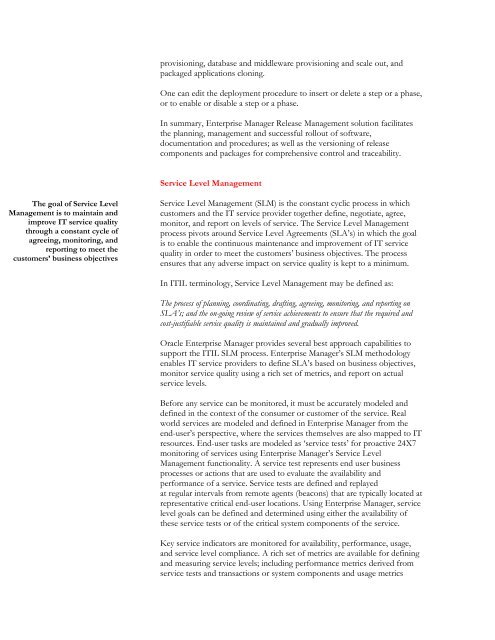ITIL Best Practices with Oracle Enterprise Manager 10g and Oracle ...
ITIL Best Practices with Oracle Enterprise Manager 10g and Oracle ...
ITIL Best Practices with Oracle Enterprise Manager 10g and Oracle ...
You also want an ePaper? Increase the reach of your titles
YUMPU automatically turns print PDFs into web optimized ePapers that Google loves.
provisioning, database <strong>and</strong> middleware provisioning <strong>and</strong> scale out, <strong>and</strong><br />
packaged applications cloning.<br />
One can edit the deployment procedure to insert or delete a step or a phase,<br />
or to enable or disable a step or a phase.<br />
In summary, <strong>Enterprise</strong> <strong>Manager</strong> Release Management solution facilitates<br />
the planning, management <strong>and</strong> successful rollout of software,<br />
documentation <strong>and</strong> procedures; as well as the versioning of release<br />
components <strong>and</strong> packages for comprehensive control <strong>and</strong> traceability.<br />
Service Level Management<br />
The goal of Service Level<br />
Management is to maintain <strong>and</strong><br />
improve IT service quality<br />
through a constant cycle of<br />
agreeing, monitoring, <strong>and</strong><br />
reporting to meet the<br />
customers’ business objectives<br />
Service Level Management (SLM) is the constant cyclic process in which<br />
customers <strong>and</strong> the IT service provider together define, negotiate, agree,<br />
monitor, <strong>and</strong> report on levels of service. The Service Level Management<br />
process pivots around Service Level Agreements (SLA’s) in which the goal<br />
is to enable the continuous maintenance <strong>and</strong> improvement of IT service<br />
quality in order to meet the customers’ business objectives. The process<br />
ensures that any adverse impact on service quality is kept to a minimum.<br />
In <strong>ITIL</strong> terminology, Service Level Management may be defined as:<br />
The process of planning, coordinating, drafting, agreeing, monitoring, <strong>and</strong> reporting on<br />
SLA’s; <strong>and</strong> the on-going review of service achievements to ensure that the required <strong>and</strong><br />
cost-justifiable service quality is maintained <strong>and</strong> gradually improved.<br />
<strong>Oracle</strong> <strong>Enterprise</strong> <strong>Manager</strong> provides several best approach capabilities to<br />
support the <strong>ITIL</strong> SLM process. <strong>Enterprise</strong> <strong>Manager</strong>’s SLM methodology<br />
enables IT service providers to define SLA’s based on business objectives,<br />
monitor service quality using a rich set of metrics, <strong>and</strong> report on actual<br />
service levels.<br />
Before any service can be monitored, it must be accurately modeled <strong>and</strong><br />
defined in the context of the consumer or customer of the service. Real<br />
world services are modeled <strong>and</strong> defined in <strong>Enterprise</strong> <strong>Manager</strong> from the<br />
end-user’s perspective, where the services themselves are also mapped to IT<br />
resources. End-user tasks are modeled as ‘service tests’ for proactive 24X7<br />
monitoring of services using <strong>Enterprise</strong> <strong>Manager</strong>’s Service Level<br />
Management functionality. A service test represents end user business<br />
processes or actions that are used to evaluate the availability <strong>and</strong><br />
performance of a service. Service tests are defined <strong>and</strong> replayed<br />
at regular intervals from remote agents (beacons) that are typically located at<br />
representative critical end-user locations. Using <strong>Enterprise</strong> <strong>Manager</strong>, service<br />
level goals can be defined <strong>and</strong> determined using either the availability of<br />
these service tests or of the critical system components of the service.<br />
Key service indicators are monitored for availability, performance, usage,<br />
<strong>and</strong> service level compliance. A rich set of metrics are available for defining<br />
<strong>and</strong> measuring service levels; including performance metrics derived from<br />
service tests <strong>and</strong> transactions or system components <strong>and</strong> usage metrics

















